Design of College English Online Teaching Platform Based on Dual-Server PEKS Framework
Abstract
To improve the English learning efficiency of college students and improve the performance of network teaching, the research on the college English network teaching platform is carried out under the dual-server PEKS framework. After systematic testing and debugging, deployment and implementation, course migration, personnel training, and other links, the system has successfully completed deployment and implementation, which strongly support the research on the college English network teaching platform. The proposed dual-server PEKS search framework makes the teaching platform more secure by designing a linear homomorphic smooth projection HASH function and solves the security loopholes of traditional PEKS. Relevant research groups have conducted questionnaire surveys and information feedback on some teachers and students and generally have a good evaluation of the online teaching platform, indicating that the system has better realized the predetermined functions and effectively supported the research on the college English online teaching platform.
1. Introduction
Most colleges and universities have undertaken major university development projects in recent years and are developing Web-assisted teaching platforms to provide the school environment. In this environment, various teaching and learning activities can be carried out [1]. It is asynchronous autonomous learning implemented through the network with the network as the carrier and under the guidance of curriculum theory and learning theory, as shown in Figure 1. Through the communication between teachers and students at different times and places, the sharing of teaching resources can be realized, so that people cannot be limited by time and space, to facilitate students' targeted individualized learning and form their own knowledge framework. The network-based teaching platform can integrate text, video, graphics, audio, and animation and form an organic whole of various teaching contents and resources and knowledge of related disciplines, to make the teaching contents more lively. At the same time, it can enable students to interact with computers, so that students can reasonably arrange and participate in teaching activities according to their needs, to effectively form a good learning motivation. On the other hand, it can effectively quantify the learning effect of students and timely feedback on the result information to teachers through network interaction, to realize the test of effective learning. Network teaching platform, also known as network teaching support platform, can be divided into broad sense and narrow sense. In a broad sense, the network teaching platform includes not only hardware and network teaching support equipment but also software systems that support the teaching network. That is to say, the broadband network is divided into two parts: a hardware command platform and a software command platform. In a narrow sense, an online reporting platform refers to a software system that follows the Internet and provides support services for online reporting. Online teaching platforms have been widely used all over the world, especially in colleges and universities [2]. The online English teaching platform is also a new type of English learning and design that has emerged with the gradual popularization of English and online learning in China. There are two reasons for its emergence. One is the English language learning and training business; the other is the advancement and popularization of network technology [3].
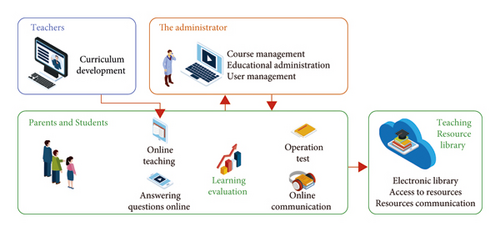
2. Literature Review
Fulkrobert and others said that building a network-based platform is an issue of concern in recent years. Many experts have contributed their part. To solve the problems related to the construction of a guidance platform suitable for online teaching [4], Kokhan and others believe that rather than passively accepting it, it is better to start first and let the practice go at the front of theory. After all, English is not a castle in the air, which has been reflected in textbooks in recent years [5]. Xiao and others believe that English is not a science that arises and disappears out of thin air. It is a kind of linguistics with the practical basis that is commonly used by a group of people [6]. Jia and others said that university textbooks are also more and more inclined to be written by people with English life background, because the articles they write have a realistic basis, are based on and cultural background, and are closer to foreign cultural life. The textbooks designed in this way have become meaningful in the examination of grammar, vocabulary, and fixed collocation [7]. Therefore, Healy and others believe that if you want to learn English well and learn a language well, it is beneficial to understand some British and American history, which requires college students to master some knowledge of English literature. After all, the best language arrangement is not linguists, but famous writers in various countries [8]. Giri and others believe that at the same time, college students should learn to use the resources on the network to learn from the main learning. Others believe that platform construction is only a part of college English online teaching. It is a good thing to get twice the result with half the effort only if this resource is reasonably utilized and every college student can benefit from the advanced platform teaching of online teaching platform [9]. Therefore, while accumulating teaching experience, Baumer and others use the new model and resources of college English reform to reasonably optimize the website platform [10]. Andrada and others said that teachers should also establish a correct concept. For example, to correctly understand this emerging media, this educational platform is an appropriate teaching resource and effective cognitive tool [11]. Pan and others believe that in addition to the initial idea of constructing the design stage of college English network platform, we also need to have a long-term vision of the sustainable development of the website, and the addition of website administrators is also a specific measure to continue the platform website [12]. Walter and others believe that learning resources are not one-time materials, but educational materials that can keep pace with the times [13].
3. Method
3.1. Dual-Server PEKS
- (1)
Setup (1λ), the safety parameter λ is taken as the input to generate the system parameter P
- (2)
KeyGen (P), the system parameter P is taken as the input, and the public key/key pair (pkFS, skFS) of the front-end server and the public key/key pair (pkBS, skBS) of the back-end server are output, respectively
- (3)
DS-PEKS (P, pkFS, pkBS, wk1), the public key pkFS of the front-end server, the public key pkBS of the back-end server, and the keyword wk1 are taken as inputs, and the PEKS ciphertext of wk is output
- (4)
DS-trapdoor (P, pkFS, pkBS, wk2), the public key pkFS of the front-end server, the public key pkBS of the back-end server, and the keyword wk2 are taken as inputs to output the trap gate
- (5)
FrontTest (P, skFS, , ), the front-end server key skFS, PEKS ciphertext , and trap gate are taken as inputs and the internal test state CITS is output
- (6)
BackTest (P, skBS, CITS), the system parameter P, the background server key skBS, and the internal test state CITS are taken as inputs, and the test result 0 or 1 is output
For the security parameter λ in the algorithm, in the asymmetric cryptographic algorithm, the key is generated by the setup algorithm, and the plaintext space of public key encryption and the message space of signature are also determined in advance by the setup algorithm. To measure the complexity of each algorithm, the security parameter λ is proposed. The security parameter is used as the input length of the asymmetric cryptographic algorithm. Through the security parameter, the efficiency and security of the scheme can be measured [15]. For the system parameter P, the system parameter P can be output through the setup algorithm with the security parameter λ as the input to generate the public key/key pair of the server.
3.2. Build an Information Network Platform
The operation of the system should meet the requirements of system diagnosis. By identifying the curriculum and characteristics of college English courses, including the functions and functions of online teaching aids, the entire operation of this Web-based service order includes five functional subfunction modules: operation order module, service management, measurement, customer communication, and management [16]. Teaching function modules usually include teaching and nonformal education services. Teachers use the system platform to realize the assistance of the teaching process, such as the push of knowledge points and the guidance of the learning process. Students can realize independent learning through the system platform. Without the limitation of time and space, students can browse the content of knowledge points, learn module videos, download teaching resources, retrieve learning materials, and complete exercises online [5]. Resource management is mainly for classroom resource management, including the download and management of textbook content, teaching materials, and resource materials. The test and evaluation module mainly realizes the assessment and evaluation of teaching effect. Through the management of question bank and test paper strategy, it can provide students with a test and evaluation platform. Through the online unit test and stage assessment, it can evaluate the effect of students' learning and file the inspection results. The user communication module only meets the communication needs of users, including instant messaging and online communication. The system management module mainly realizes the functions of system management and maintenance, user authority setting management, data maintenance, and so on [17]. The operating mode of the network-based service instruction is shown in Figure 2.
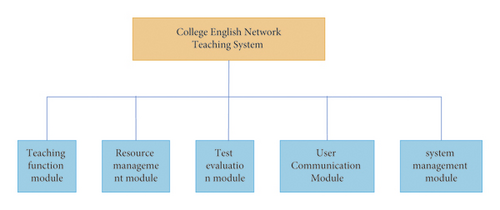
- (1)
Course Materials: it mainly includes course setting, course training objectives, electronic teaching plans, and famous teacher lectures. The course setting also includes learning contents such as syllabus, main contents, key points and difficulties, ability objectives, teaching process, and teaching courseware.
- (2)
Course Learning: it mainly includes the contents of the course chapters, online classes, principle demonstrations, textual research examples, and key points of operation.
- (3)
Auxiliary Learning: it includes animation demonstration, typical work display, virtual experiment, help skills, and other contents to assist learning.
The teaching function module is shown in Figure 3.
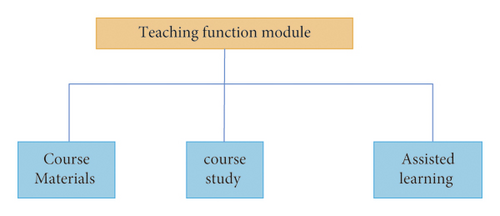
The resource management module is the support system of the teaching process, the data expression of teachers’ assisted teaching, and the knowledge carrier of students’ learning. It realizes the effective management and maintenance of various resources of the course of university English and ensures the effective use of data [19]. The main functions are as follows.
Knowledge Point Content Management: it is used to organize and manage the knowledge point content of fundamentals of university English, realize the maintenance operations such as adding, modifying, deleting, and updating the course elements such as knowledge point content, syllabus, teaching objectives, and teaching difficulties, and upload, delete, and update the teaching content such as electronic teaching plan, learning courseware, and online video.
Tutoring Material Management: it is used to add, modify, delete, update, and other maintenance and management operations of extracurricular extended learning resources of auxiliary learning.
Online Learning Record Management: it is used to record students’ learning time, login times, login time, and online situation, so that teachers can timely grasp students' learning dynamics and learning process [20].
The resource management module is shown in Figure 4.
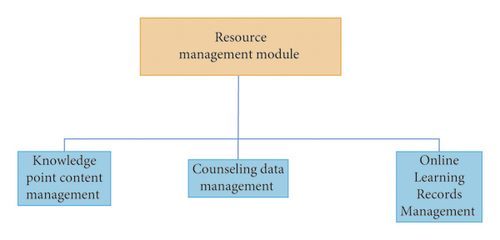
The test and evaluation module is mainly used to test the teaching effect. It is an intuitive evaluation of students’ learning achievements, including students’ phased assessment and online self-test, teachers’ question bank management, test paper generation and marking, and other functions. The main functions of this module are as follows.
Phased Assessment: phased assessment is a process assessment method formed under the basic system of college driving license examination. It is the main indicator of students’ usual performance. The phased assessment part mainly includes students’ theory examination and skill assessment and can complete homework tasks online. Since homework is usually completed without time limit, students should consider the possibility of completing one homework multiple times. At the same time, students should also be able to browse their homework that has been evaluated and corrected. Teachers should be able to manage the assessment, evaluate the submitted homework, count the results, and permanently archive the homework [21].
Online Self-Test: according to the test paper formation strategy set by the teacher in advance, the system can randomly select the test questions using the test paper formation algorithm, and the students can conduct the network-based independent test through the browser. The online self-test function has the automatic marking function for the objective questions, the teachers can evaluate the subjective questions of the test paper, and the students can query the test results in real time and archive them.
Corporate Governance and Management Questions: instructors can add, delete, and modify corporate questions and can set up tests and procedures.
The test evaluation module is shown in Figure 5.
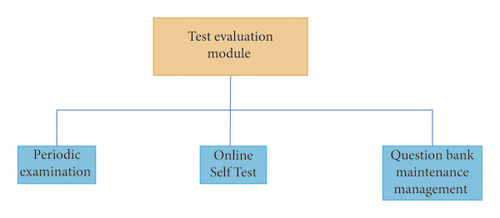
The user communication module is an important functional module to identify the interaction between teachers and students and between students and students in course activities. It is mainly used for information exchange activities between users. The module mainly includes real-time interactive online Q and A and BBS online message. Before answering the questions, teachers must first create an answering room. After entering a similar classroom, teachers and students can answer the questions in real time, so that different rooms in different teaching locations can answer questions in groups at the same time. In this way, different classes in different teaching places can answer questions in groups at the same time; BBS message realizes non-real-time online communication. The user communication module is shown in Figure 6.
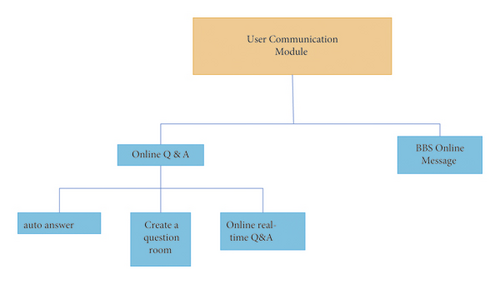
The system management module generally manages user accounts, including adding users, deleting users, modifying user data, authorizing users, maintaining system parameters, and backing up system files. The function module of the background management module is shown in Figure 7.
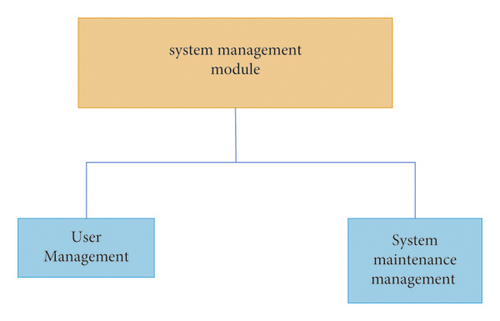
4. Results and Analysis
4.1. Performance and Security Analysis of Dual-Server PEKS
The cost storage and calculation of the planning plan and the PKE + PEKS program are always compared, and the comparison results are shown in Tables 1 and 2. In Tables 1 and 2, p, e, m, and h represent the exponential operation, bilinear mapping, multiplication operation, and hash operation, respectively; |G1| and |G2|, respectively, represent the number of bits occupied by elements on the group; and λ represents the number of bits occupied by the hash value.
| Programme | Ciphertext length | Length of trapdoor |
|---|---|---|
| Traditional scheme | 7|G1| + 2λ | 2|G1| |
| Paper scheme | 5|G1| + 2λ | |G1| |
| Programme | Encryption cost | Decryption cost | Test cost |
|---|---|---|---|
| Traditional scheme | 4p + 9e + 8m + 3h | p + e + m | p + 2e + 2m |
| Paper scheme | 8e + 4m + 5h | 2h + e | 2m + e |
To see the benefit of the comparison, the simulation is based on the pairing-based cryptography (PBC) library. The experimental equipment adopts 64 bit Windows Operating System, Core i7 Processor, and 8 GB Memory. The type A elliptic curve is selected in the experiment. Its equation is y2 = x3 + x, the embedding degree is 2, and the order q is 512 bit prime. SHA-1 is chosen according to the hash function, and the shortest length of the hash value is 160 items. The experimental results are shown in Figures 8–11 [22].
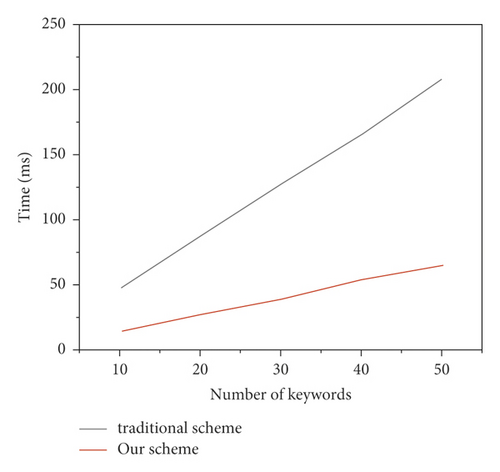
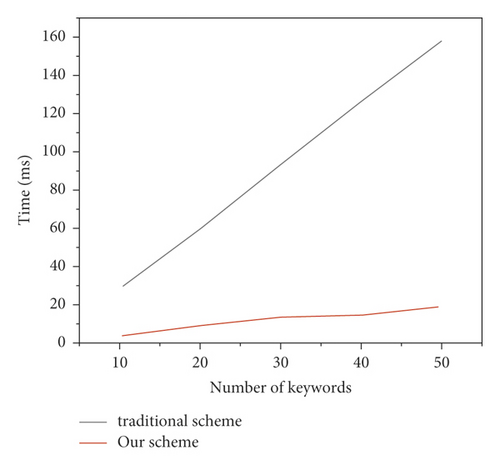
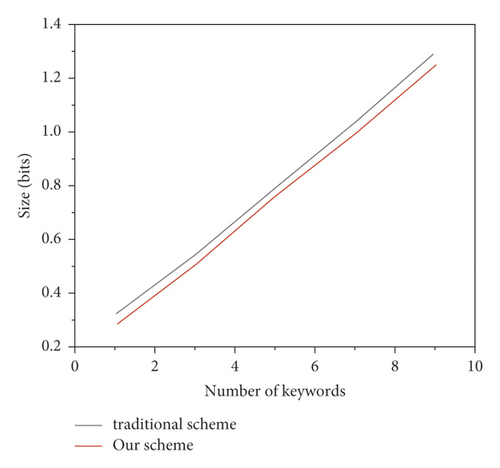
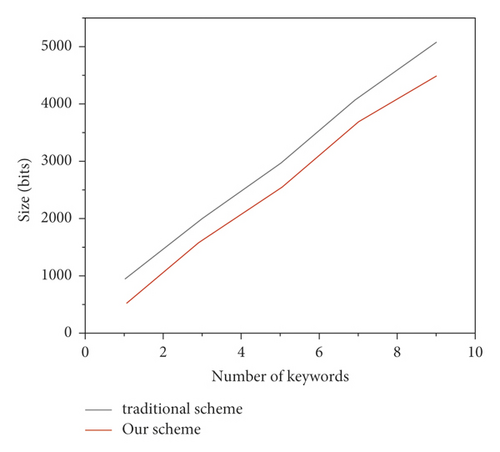
The simulation results are compared with Tables 1 and 2. The results show that, compared with the traditional process, the PKE + PEKS strategy proposed in this study is the most efficient in calculating the cost of the test algorithm and reduces the burden on the server. The scheme proposed in this study greatly reduces the calculation between users and servers.
4.2. Platform Design Analysis and Test
The learning part of the course is divided into two parts: online course learning and online course testing.
Online Course Learning: the learning system is a set of multimedia online courses, which mainly provides personalized learning for all students. The content of online courses is combined with the content of textbooks, and the content of textbooks focuses more on the training of English listening and speaking ability. The learning of e-learning course strives to create an English environment for students. The appropriate use of multimedia audio and video can make the course more vivid and play a role in creating a language environment. It is made into a two-dimensional integrated teaching system that focuses on grammar, words in classroom teaching, and listening and reading in online courses.
Online Test: the test is divided into two parts: a pretest class and a posttest class. The first test is for students to understand their own learning situation before learning and then prepare the importance of learning and learning strategies according to their own situation. Posttest is to let students know the effect of what they have just learned and what content they have not mastered and need to learn and consolidate again. The pretest questions are selected according to the learning content and learning objectives of this unit. The posttest questions can be selected in an adaptive way on the premise that the technology is possible; that is, the system can generate papers according to the students’ pretest results and the learning objectives of this unit. All tests are not necessarily in the same form as classroom tests, but learners can choose whether to control the test process by computer or by themselves, so that students can better arrange their time.
The learning of each unit is composed of three parts: unit learning outline, unit pretest, tutorial, unit posttest, and students' self-evaluation of learning.
The learning summary of the unit has three main parts: the summary describes the learning content of the unit, points out the key learning objects of the unit, and gives the basic learning objectives of the unit. These have played a role in guiding students’ learning in the process of learning the course.
Unit Pretest: it has been made clear that this part, together with the unit learning outline, has become a tool to guide students’ learning. Let learners have a detailed understanding of the unit itself and their own situation and then formulate their own personalized learning methods to study with a targeted aim, to achieve twice the result with half the effort.
Unit Tutorial: that is to say, the tutorial contents are equipped with the learning contents which students should understand and learn in this unit as well as the exercises.
Unit Posttest: a test was conducted by students after learning to understand the effect of their learning.
In addition, when providing answers to exercise questions and posttest questions, we cannot just give one answer. At present, online teaching platforms often only give answer results without giving appropriate analysis and comments. Learners can only guess and think about the solution of the problem by themselves. Therefore, appropriate analysis and evaluation should be given in the answer part, so that students can understand the context of the topic. After the students answer the questions, they should give feedback in time. For example, the objective questions should be able to be automatically evaluated by the system, and the subjective questions should be able to give the key points of the answer. If learners cannot get feedback in time, it will reduce learners’ learning enthusiasm to a certain extent.
Learners' Self-Evaluation: the evaluation method of online teaching is limited to homework and examination, and little consideration is given to learners’ own evaluation, which is very effective for learners to obtain a sense of learning achievement. After learning and testing before the course, it provides a platform for learners’ self-evaluation after learning, which is more conducive for students to think about their own learning gains and losses. Learner self-assessments in each class will allow learners to become more aware and aware of the pros and cons of their own learning and conceptual knowledge and update their curriculum and learning content over time. This plays an important role as learners develop their knowledge, allowing students to improve their learning through regular assemblies [23].
The online learning part is divided into three parts: online classroom, online BBS, and resource sharing area. Online classroom is a place where teachers can teach courses and organize teaching activities online. This is a necessary part of the network teaching platform. It is a part of teachers’ guiding role in the process of e-learning. Starting from constructivism theory, students are the masters of learning, but teachers’ guiding role also plays an irreplaceable role. Through online classroom, teachers can teach students and guide students’ learning. The online classroom also allows teachers to organize certain teaching activities, such as online group discussion and role-play because e-learning is made up of a broad range of learners, not just beginnings and endings. Online learning is concerned not only with the design and realization of educational goals but also with the process of learners’ knowledge and abilities in these processes. In the curriculum setting, students are the foundation, teachers develop and guide the curriculum and can support and help students develop curriculum points, and its role cannot be ignored. Therefore, the role of educators in online training is more than just providing information, and every step of the teaching process requires careful monitoring by organizations and professionals. Learning, communication, and comment strategies should be especially focused on. Online courses can focus on group and collaborative learning. Online courses also allow for direct communication and feedback between students and teachers. The online classroom can realize group learning and collaborative learning. The online classroom can also allow students and teachers to have direct communication and feedback, which is more direct and faster. As a result of research, teachers and students generally expect classroom style, engaging environments in which students and teachers, and students and students, can understand and communicate. In the two online teaching platforms mentioned above, there is no link of online classroom, so the network platform is more like a network courseware. Students can only study independently on the Internet, and the network platform with an online classroom is like a real online classroom, because the classroom needs the participation of teachers.
BBS is the abbreviation of bulletin board system, which means “electronic bulletin board.” It is one of the four major online communication systems. One of the characteristics of BBS is that participants can immediately see all their discussions with others. You can also see the teacher's comments. Online BBS is also a place for teachers and students to communicate, but it is only a way of asynchronous communication. Interaction is the key to all online classroom connections, both between teachers and students and between students. It not only enhances students' understanding and use of knowledge through communication with others (teachers, classmates) but also recognizes the best of both worlds in thinking and behavior in communication, even as adults learn. BBS has completely solved this insurmountable problem in traditional classroom teaching. For the questions raised by the teachers, the students can sit in front of their own computers, have a calm state of mind without tension, freely gallop their own thoughts and horses, freely release their own sense of innovation, and can also put forward new questions and opinions to communicate with any students in the class. Teachers can communicate with students and guide students at any time [24]. This provides an optimal tool for the introduction, consolidation, and application of knowledge points. The teaching design and practice of BBS communication environment not only help to stimulate, cultivate, and develop students’ creative ability but also make teachers become real teaching researchers rather than “teachers.”
Sharing is divided into the following sections.
Electronic Whiteboard: teachers can release teaching notices and other information through this whiteboard.
Shared Resource Sharing: it provides space for teachers and students to upload and download available resources. Teachers can upload classroom courseware to students here to help students review what they have not heard clearly in class. Classmates can also upload information they think useful to others.
Resource Link: it provides email addresses of teachers and students to facilitate contact and interaction. It is also a platform for teachers and each student to communicate separately.
In fact, shared areas are another form of teacher-student interaction.
Functional testing typically uses a black box to check that online instructions work according to design criteria. It mainly tests the system interface, system practicability, system logic, and whether the relevant interfaces of the system meet the requirements and meet the specifications under the permissions of student users, teacher users, and administrator users.
The system interface test mainly includes the window layout of each functional page of the system, the distribution of functional elements, art design, color matching, menu, button setting, and text font display. The practicability test mainly includes the practical effects of various functions, such as content browsing, query, video playback, file upload and download, the practicability of learning tools, online test, and scoring. The logic of the system mainly tests whether there are logical errors in test paper generation, question selection, score calculation, and so on in the online test system. The system interface mainly tests the upload of different file formats and the playback of different streaming media files at the user's customer service end. The function test is shown in Table 3.
| Test module | Test case | Test content | Test result |
|---|---|---|---|
| Interface system | Student series user, teacher series user, administrator user | Window layout, functional element distribution, art design, color matching, menu, button setting, text font display | Friendly interface, reasonable layout, convenient operation, and good test user satisfaction |
| Practicability | Student series user, teacher series user, administrator user | Practical effects of various functions | The functions meet the requirements, and all functional modules can run smoothly |
| System logic | Students complete test volume A, incomplete test volume B, and blank test volume C | Test paper generation, question selection, and score calculation | The result is normal |
| System interface | Student series user, teacher series user, administrator user | Uploading of different file formats and playing of different streaming media files at the customer service end | All interfaces are normal |
The performance of network teaching platform will directly affect the use of users. The performance test is mainly to detect the server performance, connection speed, load, and other conditions when the system is running. Server performance mainly refers to the server system resources that need to be consumed when the system runs. The fast connection usually refers to the response time of the system to the request, and the load is usually related to the pressure the system can withstand. This experiment uses a combination of real-world equipment and experimental simulation equipment. In the 100M site local area network and 10ADSL dial-up network environment, 20 to 100 users log on to the home page at the same time, enter the complete and browse the content of the familiar content, and then try it online. Now, they work on the system when downloading queries. The performance test is shown in Table 4.
| Test module | Test case | Test content | Test result |
|---|---|---|---|
| Spatial performance | Server: Quad-Core CPU, 4G memory; client: 2-Core CPU, 1G memory | Consumption of system resources of server and client | Smooth operation and low resource consumption of the system |
| Average response speed | Ethernet LAN client; 10 m broadband client | Customer service browser acceptance response time | <1 second |
| System load | 200 Ethernet LAN clients | Simultaneous access and online test | Simultaneous access is normal, while online testing lags |
It can be seen from the above measured data that the system has a good response and can ensure that users operate normally under the network environment supported by installation, intermediate server configuration, and daily use.
Security test mainly includes login security test (invalid user name and password test, case sensitivity test, whether you can browse a page directly without login, etc.); page timeout re-login test; log file test; and SQL injection and illegal file upload. The security test is shown in Table 5.
| Test module | Test case | Test content | Test result |
|---|---|---|---|
| System login | Legal and illegal user names of each authority | Effective allocation and restriction of permissions, user login | User password and authority verification are normal |
| Page timeout | Login timeout | Login timeout response mechanism | Exit login status |
| Log file | Access platform of each authority | Are relevant data and operation logs recorded | Complete record |
| SQL injection | Common SQL injection statements | Check for SQL injection vulnerabilities | No vulnerabilities found |
| File upload | Legal and illegal file upload | Upload executable files with permission, and upload executable files without permission | No file upload vulnerability found |
5. Conclusion
By investigating the multilevel and multifaceted needs of frontline teachers and students in College English teaching, starting from constructivist teaching theory, this study gives a set of design strategies for a new network teaching platform and puts forward a system functional framework of the network teaching platform. The principles of platform practice and test question typesetting are put forward: first, easy operation, simple steps, and fast system response. Second, multimedia audio and video are used to train students' listening, reading, and speaking ability. At present, some network platforms, including network courseware, like to design a variety of question types in the production process, but through the analysis of the research results, the vast majority of students hope that the design of practice question types should be easy to use, and too cumbersome steps will make them lose interest in learning. Finally, the study gives a new functional architecture of network teaching platform. The system is designed with students as the main body and teachers as the guiding teaching strategy. The whole system includes four parts: tutorial learning, online learning, extracurricular reading, and network resource sharing. Each part has its own functional architecture. Overall, these four parts are arranged in a gradient from the degree of importance. First, tutorial learning can be carried out if each learner enters the network platform. It is also the most basic learning process of the network platform and a learning process of learners' complete autonomy.
Conflicts of Interest
The authors declare no conflicts of interest.
Acknowledgments
This work was supported by the Zhengzhou Normal University.
Open Research
Data Availability
The labeled datasets used to support the findings of this study are available from the corresponding author upon request.




